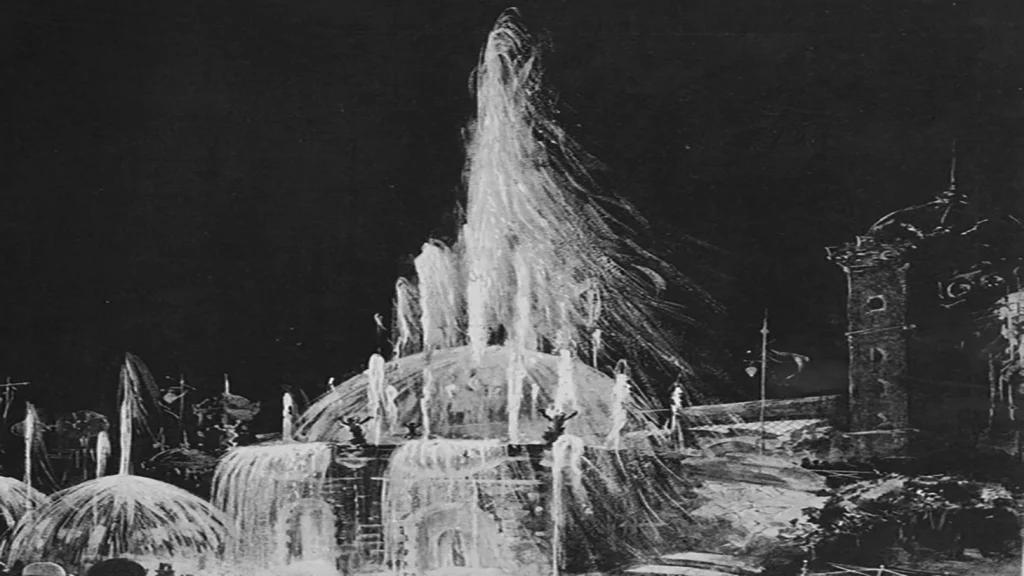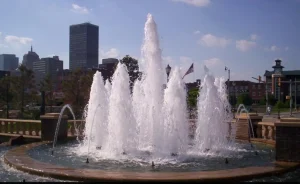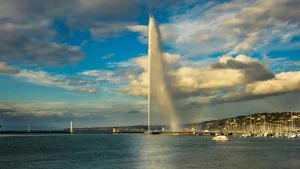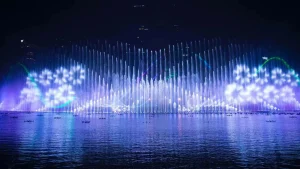- May 23, 2022
- huaxin

Musical Fountains: The earliest choreographed musical fountains
The earliest musical fountains were played manually by a live operator, who usually controlled pumps or valves and sometimes lights by way of switches on a control panel. Music was almost always live. Later, choreography could be prerecorded on a punched paper card which was scanned by a computer; and even later, it could be recorded on magnetic tape or, in the most modern shows, on a CD along with the music. Even so, the choreography is still usually painstakingly programmed by hand, some types of shows being played live from a control console and connected to a computer that records the operator’s actions for later automatic playback. Recent advances in technology provide for unattended automatic choreography that can rival manual programming.
The Bodor Fountain
Péter Bodor (June 22, 1788 – August 17, 1849) was a Hungarian mechanical engineer who built a musical or chiming fountain in the Transylvanian town of Marosvásárhely (now Târgu Mureş, Romania) between 1820 and 1822. His fountain had a round floor plan, with two arched stairs on the sides, and a dome roof supported by six pillars. The mechanical core was a hydraulic structure driven by the force of water that played popular chimes every six hours. There was a gilded Neptune (or Apollo) statue on the top, that turned round in 24 hours. The musical device was destroyed in 1836 by a snowstorm and was never restored. The fountain itself was demolished in 1911. An almost identical copy was built on Margaret Island of Budapest in 1935−1936 that did not operate by hydraulic means but used electricity instead.
Křižík's light fountain
Křižík’s light fountain was built by the Czech inventor and electrical engineer František Křižík in 1891 on the occasion of the World Exhibition in Prague. It became a unique European attraction. The fountain was rebuilt in the 1920s by architect Z. Stašek. The bottom of the fountain plate is equipped with 1300 multicolored reflectors and water circuits composed of more than two kilometers of pipes with almost 3000 nozzles. In June 2018, the fountain has interrupted its operation.
The work of F.W. Darlington
F.W. Darlington was a pioneer in electrical fountain control as well as water design.
Prismatic Fountain, Denver, Colorado
In 1908, Darlington constructed a fountain in Denver City Park lake for US$19,577. It featured eleven colored light streams that were controlled by an operator. In 2009, the fountain was restored using modern technology for US$3,200,000.
Prismatic Fountain, New Orleans, Louisiana
The Darlington fountain in West End, New Orleans was likely completed around 1915 or 1916 as the last date on the original drawings is from February 1915. The fountain served as an icon for the West End Park and surrounding yacht clubs and numerous restaurants that were located in the area.
All of Darlington’s fountains required an operator to change the water effects and lighting and were likely used in conjunction with music played by a band or orchestra for special events. It is unknown if the fountain was operated in a static mode when there were no performances or if it was shut off.
Restoration of this fountain is planned by the Friends of West End in New Orleans.
Garfield Park, Indianapolis, Indiana
In 1915, the new greenhouses and conservatory were built in Garfield Park, Indianapolis. The dedication of the Sunken Garden took place on October 29, 1916. In 1916, Darlington was hired to design and build the fountains at the east end of the Sunken Garden. The fountains were the first in the country to be equipped with the mechanics that allowed the changing of the spray and displayed lights, according to the season and holiday. For Memorial Day, the fountain’s lights were alight with red, white, and blue, and on other days, gold and white. Today, the fountains are still an attraction for visitors. This fountain was restored by The Fountain People in 1997 and with a musical control system by Atlantic Fountains in 2003.
Pool of Industry, 1939 New York World's Fair
An early notable example of a musical fountain choreographed live was the Pool of Industry at the 1939 New York World’s Fair, where three operators controlled the fountain, guided by a paper program that unscrolled under a glass window like the paper roll of a player piano – rather than controlling the effects directly like a piano roll, it was marked with commands that told the operators when to push the buttons and throw the switches. This fountain was more than just water and lights, however. Besides 3 million watts of lights and a gigantic pool containing 1,400 water nozzles, there were over 400 gas jets with a mechanism that caused colored flames, and fireworks were shot from over 350 launchers, creating a nighttime spectacle on a grand scale.
Music was played live by the fair’s band and broadcast by large speakers to the areas surrounding the display. The updated show displayed at the same fairgrounds in 1964 lacked the colored flames but used punched cards for the choreography, had prerecorded music, and utilized the then-revolutionary system of dichroic light filtering which now allowed a dark-colored lens and a light-colored lens to produce the same brightness of a light. It was by this process that 700,000 watts of light produced over 3 mega candelas. This show also had single lights with multiple sliding color filters for mixing colors, and arrays of nozzles that could be adjusted, their direction changed by hydraulic or pneumatic actuators.
Share:
More Posts

How To Choose The Right Lighting Wattage For Your Fountain Project
How To Choose The Right Lighting Wattage For Your Fountain

Misunderstandings In The Planning And Design Of Waterscape Fountain Projects In The Industry
This article mainly introduces the three major misunderstandings in the

Basic information required for the overall planning of the water fountain
According to statistics from relevant parties, more than 75% of

Design And Build A Good Fountain To Grasp The Key Elements
The input cost of fountains is relatively large. In the